Rockery - what is it and how to make it correctly?
The artistic arrangement of a suburban area is necessary so that the territory surrounding the buildings expresses the taste and values of the life of the owner of the house. There are so many landscape design options that it is difficult to find the perfect one. After all, you need to get acquainted with each of them, learn about the features of their appearance and design. The popularity of rockeries is that it has different forms, it can occupy both a small area and a large space.
It is not difficult to arrange a rockery on the territory of your site, if you know the design features, choose the appropriate style of its device. It is possible to create a plant-stone composition not only on the flat surface of the summer cottage, but also where there are low-lying places, small hills.
Content:
- Rockery - what is it?
- Types and styles of rocky garden
- Choosing a place for arranging rockeries
- Methods for decorating a decorative flower bed
- Selection of plants for rockeries
- Stone compositions in the design of the garden
Rockery - what is it?
The name of the landscape composition contains an English word meaning stone, rock. Without them, there will be no rockery. As soon as they do not call the stony-plant union: both an alpine hill and a rocky flower bed. This is all correct and not entirely true.
The rockery is based on a combination of harmoniously selected natural stones and graceful plants and shrubs.
And although it is confused with a rock garden, there are differences. Usually, when creating compositions, huge sharp blocks are not used, and there is no tiering in them either. The main thing in rockeries is the imitation of a mountain landscape, but the garden can be located not only on a hill, but also in the lower part of the garden. Often the combination of plants and stones is permanent, but many people like to change stones and plants to different species every year. The composition may change during one season.
Distinctive for rockeries is the use in combination of representatives of conifers or those plants that are most unpretentious to growing conditions. There is no exact shape for a rocky flower bed. It can be both huge and miniature. Rockeries serve as a framing for lawns, part of mixborders or a continuation of landscape compositions. The popularity of this type of design construction in its uniqueness, variety of forms.
Types and styles of rocky garden
Among the rockery species, there are variable and stable. If the owner of the garden loves changes that correspond to his mood, is ready to constantly experiment, then he will like constantly changing compositions. Having created a base of undersized trees or shrubs, using small stones, they change the types of flowers for the flower bed every year. And the form of rockery lends itself to change in this case.
Permanent forms require thoroughness in their design. They pick up more stones, dig them into the ground. And from plants they choose perennials, shrubs, small trees, changing only the crown by pruning. This type of rockery should ideally blend in with the surrounding landscape.
Mobile versions of flower beds are also interesting, when miniature plants are placed in stone bowls, concrete blocks or logs with a hollowed out middle.
There are different rockeries in style:
- The European-style garden is replete with plants of the middle zone. When creating, preference is given to plants of continuous flowering. Shrubs that delight with bright red foliage, perennial grasses, beautiful ground cover species of perennials are also used.
- The English landscape is characterized by austerity and consistency of form, the presence of conifers, cereals, and various greenery.
- The classic version of a rocky garden is Japanese. It has more stone compositions than plants.
- The main features of the tropical rockery are the splendor of the vegetation. In the creation of the composition, some layering is assumed - below are creeping species, and above are plants with large leaves, bright flowers. They combine the structure and wooden sculptures into a single whole.
The choice of style depends on the taste of the owner, the purpose of creating a rocky garden: for a festive mood or philosophical reflections.
Choosing a place for arranging rockeries
Before creating a rocky flower bed, think over its shape, select a place on the site. It should be suitable for those plants that will be in the garden. Rockery should be in harmony with its surroundings, naturally complement the landscape.
Changing the height of the relief, combining a garden with an artificial reservoir or a natural stream, it is necessary to proceed from the fact whether the rockery will be combined with them, whether it will bring dissonance into the harmony of the natural corner. You cannot place the composition near fences, buildings.
To create a garden, a site with dense soil, deep groundwater is suitable.
Do not think that rockery is just a pile of stones scattered along the islets of vegetation. Before embarking on the implementation of a design idea, everything is carefully thought out, planned.
Methods for decorating a decorative flower bed
There are several ways to create rockeries, but they always start with creating a foundation for a garden. To do this, mark the boundaries of the future composition. They can be either smooth or winding. All sod from the site is removed and geotextile is applied to this place. Then comes a layer of drainage, sand. To make the base rigid, it is well compacted. After that comes the turn of the soil substrate, consisting of garden soil, sand with the addition of peat and crushed stone. If it is conceived to make small mounds or depressions in the garden, then they are immediately laid out.
Since rockeries are based on stones, they are not picked up randomly, but so that they complement each other.
You can choose two or three cobblestones, and plant flowers around them. Smooth pebbles are selected for the garden at the edge of the reservoir, and rough, large specimens on the dais. A large stone of expressive appearance placed on a flower bed can become the basis of a garden structure. The rest will only have to emphasize its uniqueness.
The combination of stones in color and texture plays an important role in the composition. Do not focus on gray boulders. They can be orange, beige or black in color. They always begin to lay out large-sized stones, making compositions of them. Cobblestones are a little buried in the soil, adding a cushion of rubble or concreting the area. After arranging the elements of inanimate nature, planting begins. They choose those that can bloom throughout the summer, or the flowering of one species replaces another.
First of all, lignified types of horticultural crops are planted, then they move on to perennials, bulbous, ground cover. The last will be the annuals. For rockeries, 10-15 types of crops are enough. At the end of the creation of the garden, begin filling the empty areas with colored gravel. Fancy patterns are placed on top using stones of various shades.The final rocky flower bed will be ready when the composition will be changed several times in order to achieve harmony in it.
Selection of plants for rockeries
It is necessary to choose plants for a stony-floral union taking into account their compatibility with each other. Two-thirds of the garden is devoted to ground cover and perennial crops. The rest is distributed among conifers, deciduous shrubs, trees:
- Conifers need a fertile soil layer with a thickness of half a meter. Of these, their choice is set on dwarf spruce trees, thue, juniper, balsamic or Korean fir.
- From deciduous trees, dwarf species are suitable for rockeries barberry, heather, japanese quince, boxwood.
- Ground cover includes tenacious, cuckoo clover, gypsophila.
- Bulbous perennials are represented on a rocky flower bed. crocuses, daffodils, undersized tulips, cyclamen.
- To make the garden more natural, use mosses, phloxes, cat's paw.
- They will revive the grayness of the stone with bright colors primrose, hyacinths, geranium.
- The device of temporary rockeries takes place with the sowing of annual flowers: lobelia, limnantes, diastia.
It is necessary to select plants taking into account the style of the flower bed.
Stone compositions in the design of the garden
Among the stones, limestones, sandstones, granite or artificial options are often chosen. There are many ways to place boulders:
- Cobblestones are placed on the slope in the form of a terrace, fastening the parts with concrete.
- Huge boulders located on the slopes create imitation of rocks. In these cases, volcanic rocks are used. Dolomite and travertine will also look good.
- Between the hills, you can create a gorge from stones of different heights by cementing the walls. The dry masonry method is also suitable here.
- At first glance, a chaotic pile of stones will connect flower beds, water, lawn.
Additionally, rockeries are decorated with LED lanterns, miniature sculptures. The main thing is to feel the taste and unity of the composition in everything.
More information can be found in the video:



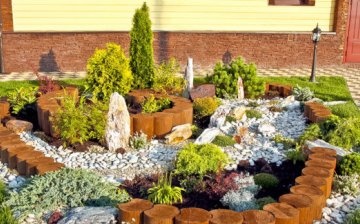
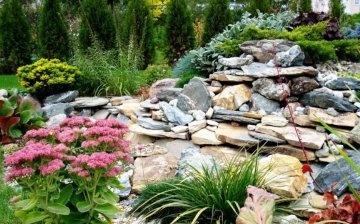
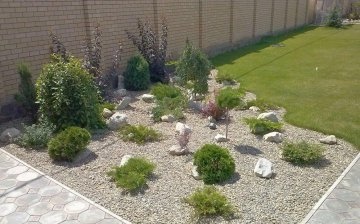


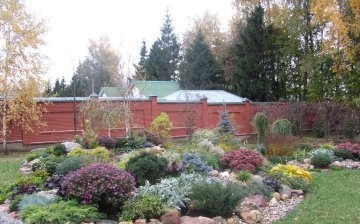
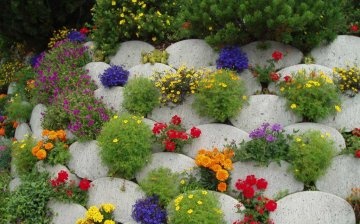







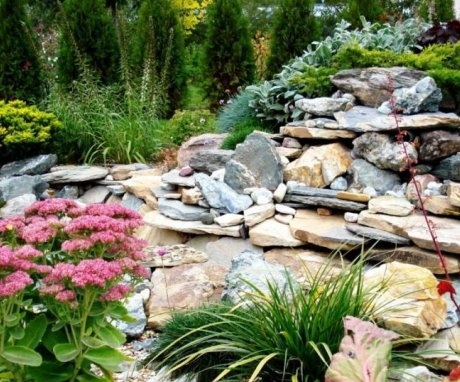
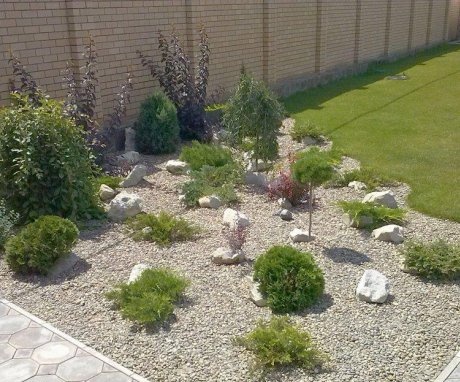
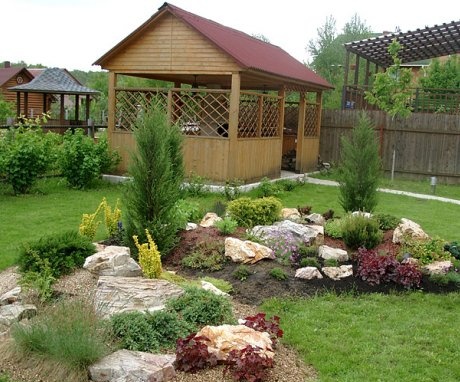
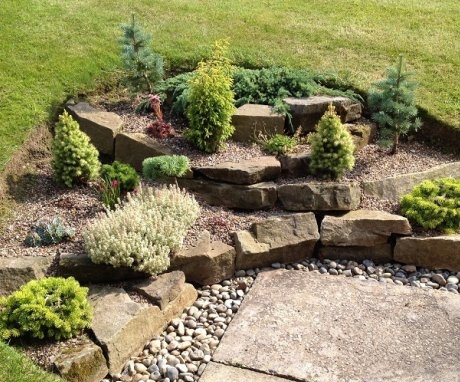

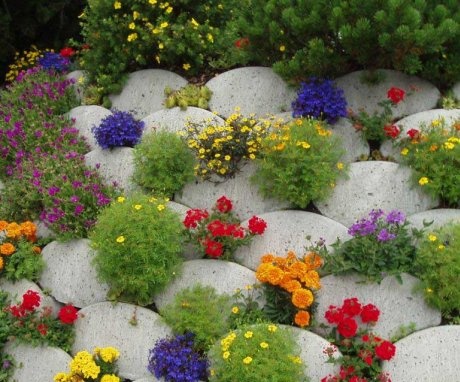
Quite interesting compositions of stones and various plants are given in the article. I prefer the rockery, located on a small mound of the site. It should contain stones of various sizes, and from plants - perennial shrubs and flowers, as well as creeping vines.
A very interesting style, and most importantly, natural. Stones in combination with flowers seem to come to life, the strength of the rock is smoothed out by the tenderness and fragility of flowering plants - this is a great idea!
Rockery is a very interesting activity that can be practiced for years, improved and supplemented with new "exhibits". But it requires both knowledge and skills, and the costs will always be justified by an unusual and rich look.
I am familiar with the alpine slide, but rockery is not familiar to me. There are some similarities, of course, but there are also differences. For a long time I have been thinking of equipping my site with such beauty, I will start in spring with stones and unpretentious plants, and over time I will add more beautiful and demanding